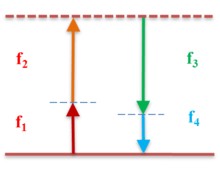Four-wave mixing
Four-wave mixing (FWM) is an intermodulation phenomenon in non-linear optics, whereby interactions between two or three wavelengths produce two or one new wavelengths. It is similar to the third-order intercept point in electrical systems. Four-wave mixing can be compared to the intermodulation distortion in standard electrical systems. It is a parametric nonlinear process, in that the energy of the incoming photons is conserved. FWM is a phase-sensitive process, in that the efficiency of the process is strongly affected by phase matching conditions.
Mechanism

When three frequencies (f1, f2, and f3) interact in a nonlinear medium, they give rise to a fourth wavelength (f4) which is formed by the scattering of the incident photons, producing the fourth photon.
Given inputs f1, f2, and f3, the nonlinear system will produce
with the most damaging signals to system performance calculated as
since these frequencies will lie close to one of the incoming frequencies.
From calculations with the three input signals, it is found that 12 interfering frequencies are produced, three of which lie on one of original incoming frequencies.
Degenerate four-wave mixing
Four-wave mixing is also present if only two components interact. In this case the term
couples three components, thus generating so-called degenerate four-wave mixing, showing identical properties as in case of three interacting waves.
Deleterious effects of FWM in fiber-optic communications
FWM is a fiber-optic characteristic that affects wavelength-division multiplexing (WDM) systems, where multiple optical wavelengths are spaced at equal intervals or channel spacing. The effects of FWM are pronounced with decreased channel spacing of wavelengths (such as in dense WDM systems) and at high signal power levels. High chromatic dispersion decreases FWM effects, as the signals lose coherence, or in other words, increases the phase mismatch. The interference FWM caused in WDM systems is known as interchannel crosstalk. FWM can be mitigated by using uneven channel spacing or fiber that increases dispersion.
Applications of FWM
FWM finds applications in optical phase conjugation, parametric amplification, supercontinuum generation and in microresonator based frequency comb generation. Parametric amplifiers and oscillators based on four-wave mixing use the third order nonlinearity, as opposed to most typical parametric oscillators which use the second-order nonlinearity.